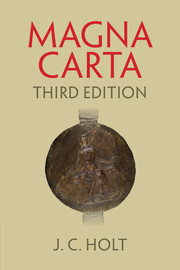Book contents
- Frontmatter
- Dedication
- Contents
- List of plates
- Preface to third edition
- Preface to second edition
- Preface to first edition
- Acknowledgements
- Abbreviations
- Introduction
- 1 The Charter and its history
- 2 Government and society in the twelfth century
- 3 Privilege and liberties
- 4 Custom and law
- 5 Justice and jurisdiction
- 6 Crisis and civil war
- 7 Quasi Pax
- 8 The quality of the Great Charter
- 9 The achievement of 1215
- 10 From distraint to war
- 11 The re-issues and the beginning of the myth
- Appendices
- 1 The meeting at Bury St Edmunds, 1214
- 2 Notification of Thomas count of Perche, February 1215
- 3 Triplex forma pacis
- 4 The ‘unknown’ charter
- 5 The Articles of the Barons
- 6 Magna Carta, 1215
- 7 Translations of the Charters
- 8 The Twenty-Five barons of Magna Carta, 1215
- 9 The date of the London treaty
- 10 The Oxford Council, 16–23 July 1215
- 11 Select documents illustrative of the history of Magna Carta, 1215
- 12 Magna Carta, 1225
- 13 Charter of the Forest, 1225
- 14 Liberties and perpetuity
- References
- Index
- Plate section
3 - Triplex forma pacis
from Appendices
Published online by Cambridge University Press: 05 July 2015
- Frontmatter
- Dedication
- Contents
- List of plates
- Preface to third edition
- Preface to second edition
- Preface to first edition
- Acknowledgements
- Abbreviations
- Introduction
- 1 The Charter and its history
- 2 Government and society in the twelfth century
- 3 Privilege and liberties
- 4 Custom and law
- 5 Justice and jurisdiction
- 6 Crisis and civil war
- 7 Quasi Pax
- 8 The quality of the Great Charter
- 9 The achievement of 1215
- 10 From distraint to war
- 11 The re-issues and the beginning of the myth
- Appendices
- 1 The meeting at Bury St Edmunds, 1214
- 2 Notification of Thomas count of Perche, February 1215
- 3 Triplex forma pacis
- 4 The ‘unknown’ charter
- 5 The Articles of the Barons
- 6 Magna Carta, 1215
- 7 Translations of the Charters
- 8 The Twenty-Five barons of Magna Carta, 1215
- 9 The date of the London treaty
- 10 The Oxford Council, 16–23 July 1215
- 11 Select documents illustrative of the history of Magna Carta, 1215
- 12 Magna Carta, 1225
- 13 Charter of the Forest, 1225
- 14 Liberties and perpetuity
- References
- Index
- Plate section
Summary
The basic passage for the discussion of the triplex forma pacis occurs in letters of 5 September, covering the papal mandate ‘Mirari cogimur’, in which the papal agents in England excommunicated the leading baronial rebels. These were printed for the first time from the original by Sir Maurice Powicke in 1929. The passage is as follows: ‘nobiles viri … et multi alii complices et fautores ipsorum coniurationibus et conspirationibus illicitis contra dignitatem regiam colligati contra ipsum Regem et pacem regni, quod est patrimonium Beati Petri, arma movere nequiter presumpserant et contra triplicem formam pacis quarum quelibet honesta et rationabilis erat et a viris Dominum timentibus merito acceptanda ipsum dominum suum contemptibiliter diffidarunt, fidelitatis sibi prestite vinculo dissoluto.’ It is placed in an exact relationship to the chronology of the events of the spring of 1215. It is clear that the triplex forma pacis preceded the baronial defiance and it is equally clear that this was the defiance made at the beginning of May, since it is followed by a reference to the fall of London (17 May), which the barons seized ‘contempta forma pacis quam dominus Papa presentibus et consentientibus eorum nuntiis providerat observandam’. Taken together these two passages establish that the triplex forma pacis was in fact the settlement which the pope announced in the letters of 19 March, and this is confirmed by Innocent's letters of 18 June which refer to the ‘formam descriptam superius a (nobis) nuntiis eorum presentibus cum multa deliberatione provisam’.
However, Powicke argued that the triplex forma pacis was Magna Carta. He overlooked the letters of 19 March and the reference to a forma in the letter of 18 June. He then thought that the participation of the pope's ‘familiar’ in the agreement at Runnymede made the settlement between the king and baronage ‘triplex’, and, finally, that Pandulf and the other papal agents would not have ‘cynically’ disregarded so striking and recent a settlement as Magna Carta. These arguments were further developed in 1945 by H. G. Richardson, who argued that the letters of 5 September referred to a second baronial defiance which was an essential prefatory step, in his view, to the renewal of war in the autumn; and in 1963 by Richardson and Sayles, who maintained that the letters of 18 June made no reference to a concordia at Rome.
- Type
- Chapter
- Information
- Magna Carta , pp. 341 - 344Publisher: Cambridge University PressPrint publication year: 2015



